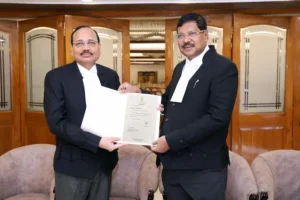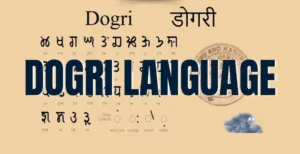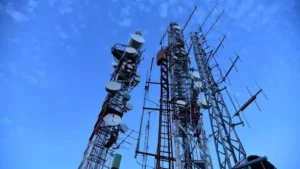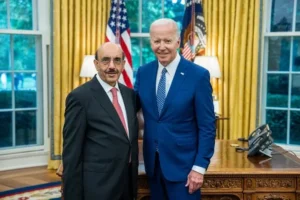1. Justice Surya Kant Recommended as 53rd Chief Justice of India – Polity

Why in News?
Chief Justice of India (CJI) D.Y. Chandrachud (Note: Please verify name; the document says Gavai, but current CJI is Chandrachud as of Oct 2025) has recommended Justice Surya Kant, the senior-most judge of the Supreme Court, to become the 53rd Chief Justice of India.
Key Highlights
About the Chief Justice of India (CJI)
The Chief Justice of India (CJI) is the head of the judiciary system and the Supreme Court, the apex judicial authority in India.
The CJI is often referred to as the “Master of the Roster“, i.e., responsible for:
Constituting benches
Allocating cases
Scheduling court hearings
Constitutional & Legal Provisions
| Provision/Aspect | Details |
|---|---|
| Article 124 | Deals with appointment of Supreme Court judges including the CJI |
| Article 145 | Empowers the CJI to form Constitution Benches for key constitutional matters |
| Tenure | Till the age of 65 years |
| Removal | Only through impeachment by Parliament for proven misbehavior/incapacity |
| Qualifications | – Indian citizen – 5 years as High Court judge or – 10 years as advocate in High Court or – A distinguished jurist (as recognized by the President) |
Appointment Process
Convention of Seniority: The senior-most judge of the Supreme Court is typically recommended as the next CJI.
Procedure:
Outgoing CJI recommends successor.
The Law Minister forwards it to the Prime Minister.
PM advises the President, who then formally appoints the new CJI.
Role & Responsibilities
Judicial Functions
Presides over constitutional benches and major cases.
Sets legal precedents that guide lower courts.
Administrative Duties
Oversees court management, registry operations, and judicial appointments in SC.
Plays a central role in appointments and transfers of High Court judges through the Collegium System.
Significance of the Recommendation
Reflects continuity and institutional integrity in the judiciary.
Ensures experienced leadership to handle pending constitutional matters, judicial reforms, and technological modernization of courts.
Exam Connect – Possible Questions
Prelims
1. Who appoints the Chief Justice of India?
A. Prime Minister
B. President
C. Law Minister
D. Parliament
Answer: B. President
2. Which Article of the Constitution deals with the formation of Constitution Benches by the Chief Justice?
A. Article 124
B. Article 143
C. Article 145
D. Article 148
Answer: C. Article 145
Mains
1.Discuss the process of appointment of the Chief Justice of India. In your opinion, should the convention of seniority be re-evaluated to ensure merit-based appointments?
2.The Chief Justice of India is often called “first among equals.” Critically examine the judicial and administrative powers vested in the office of the CJI.
2. Election Commission Launches Special Intensive Revision (SIR) of Electoral Rolls –Polity

Why in News?
The Election Commission of India (ECI) has launched a Special Intensive Revision (SIR) of electoral rolls across 12 States and Union Territories, covering approximately 51 crore electors.
This is the first nationwide SIR since 2002–2005, aiming to eliminate:
Duplicate entries
Migrated individuals
Ineligible voters
The exercise seeks to verify voter eligibility, improve accuracy, and enhance public trust in the electoral process.
Key Highlights
What is Special Intensive Revision (SIR)?
A detailed, door-to-door verification process of the electoral rolls.
Conducted to clean up voter lists and ensure only eligible citizens are included.
Part of ECI’s commitment to free, fair, and transparent elections.
Objectives of the SIR
Update electoral rolls with accurate and verified data.
Remove:
Duplicate registrations
Deceased individuals
Migrants and ineligible entries
Confirm citizenship and eligibility of newly registered electors.
Background & Legal Context
| Aspect | Details |
|---|---|
| Past Precedent | Last major SIR was conducted between 2002–2005 |
| Legal Mandate | ECI operates under Article 324 of the Constitution |
| Elector Verification | Mandated for all registered voters, especially post last revision cycle |
| Deadline for Submission | Electors must submit updated enumeration forms by 4 December 2025 |
Coverage Area
The 12 States/UTs where the SIR is being implemented:
Andaman & Nicobar Islands
Chhattisgarh
Goa
Gujarat
Kerala
Lakshadweep
Madhya Pradesh
Puducherry
Rajasthan
Tamil Nadu
Uttar Pradesh
West Bengal
Note: Assam is excluded due to the ongoing National Register of Citizens (NRC) process.
Operational Details
Around 5.33 lakh Booth Level Officers (BLOs) have been mobilized.
House-to-house verification to be carried out.
Voters must:
Verify their details.
Submit proof of eligibility and citizenship.
Challenges & Concerns
Legal scrutiny over citizenship verification methods.
Fears of exclusion/disenfranchisement of genuine voters.
Political opposition questioning the transparency and intent of the exercise.
Logistical burden due to scale and tight timeline.
Significance of the SIR
Enhances credibility of elections.
Helps tackle electoral fraud, bogus voting, and inaccurate rolls.
Reinforces democratic legitimacy by ensuring a clean voter list.
Exam Connect – Possible Questions
Prelims
1. Which of the following constitutional articles empowers the Election Commission of India to conduct elections and revise electoral rolls?
A. Article 326
B. Article 324
C. Article 325
D. Article 323B
Answer: B. Article 324
2. Which of the following States/UTs is not covered under the Special Intensive Revision (SIR) launched by the ECI in 2025?
A. West Bengal
B. Assam
C. Tamil Nadu
D. Gujarat
Answer: B. Assam
Mains
1.Discuss the significance of the Special Intensive Revision (SIR) of electoral rolls launched by the Election Commission in 2025. What challenges does the process face, and how can they be addressed?
2.”Electoral roll accuracy is the foundation of free and fair elections.” Critically examine this statement in light of recent reforms by the Election Commission of India.
3. Need for Preserving Dogri Language – Indian Society

Why in News?
A recent study has highlighted the sharp decline in the use and literacy of the Dogri language in Jammu and Kashmir. Despite its official recognition, Dogri faces a generational disconnect and policy neglect, raising concerns about the erosion of regional linguistic heritage.
Key Highlights
Dogri, a regional Indo-Aryan language, is witnessing:
Declining use among urban youth
Low literacy and proficiency
Weak institutional and educational support
India has already lost 220+ languages in the last 50 years, making it the country with the highest number of endangered dialects globally.
About Dogri Language
| Aspect | Details |
|---|---|
| Language Family | Indo-Aryan branch of Indo-European language family |
| Primary Regions Spoken | Jammu region (J&K), Himachal Pradesh, and among Dogri-speaking diaspora |
| Cultural Significance | Rich in folklore, oral traditions, literature, crafts, and music |
| Official Status | – Included in the Eighth Schedule of the Indian Constitution (2003) – Recognized in the J&K Official Languages Act, 2020 |
Reasons for Decline
1.Policy Neglect:
Limited use of Dogri in administration, education, and public broadcasting.
Lack of state-sponsored promotion.
2.Generational Disconnect:
Youth perceive Dogri as socially backward or economically irrelevant.
Preference for English and Hindi in education and employment.
3.Urbanization & Migration:
Shift from rural to urban lifestyles has reduced native language transmission.
4.Low Institutional Support:
Minimal presence in digital media, academia, and tech platforms.
Scarcity of Dogri-language educational resources and professional opportunities.
Implications of Language Loss
Cultural Erosion: Loss of literature, idioms, folk wisdom, and traditional knowledge.
Identity Crisis: Weakens community identity and inter-generational bonding.
Threat to Linguistic Diversity: Goes against India’s multicultural ethos.
Measures Needed for Preservation
1.Education Policy Reforms:
Incorporate Dogri in school curriculum and teacher training.
Promote bilingual/multilingual education models.
2.Digital Promotion:
Create Dogri-language apps, YouTube content, and online learning tools.
Support local content creators and publishers.
3.Institutional Backing:
Strengthen Dogri departments in universities.
Offer scholarships and incentives for Dogri-language research and study.
4.Link Language with Livelihood:
Develop cultural tourism centered on Dogri heritage.
Use Dogri in local governance, judiciary, and media to enhance visibility.
Significance for Indian Society
Strengthens India’s linguistic pluralism and cultural federalism.
Empowers regional identities within the constitutional framework.
Enhances social inclusion and cultural sustainability.
Exam Connect – Possible Questions
Prelims
1. Dogri language belongs to which of the following language families?
A. Dravidian
B. Sino-Tibetan
C. Indo-Aryan
D. Austroasiatic
Answer: C. Indo-Aryan
2. In which year was Dogri included in the Eighth Schedule of the Indian Constitution?
A. 1950
B. 1992
C. 2003
D. 2020
Answer: C. 2003
Mains
1.The decline of regional languages like Dogri poses a threat to India’s linguistic and cultural diversity. Examine the causes of this decline and suggest comprehensive measures for their preservation.
2.”Language is more than a means of communication; it is a repository of identity, history, and culture.” In the light of this statement, discuss the importance of preserving indigenous and regional languages in India.
4. A Start for North–South Carbon Market Cooperation – International Relations
Why in News?
On September 17, 2025, India and the European Union (EU) announced a New Strategic EU–India Agenda, marking a significant advancement in bilateral cooperation. A central feature is the proposed linkage between:
India’s Carbon Market (ICM)
EU’s Carbon Border Adjustment Mechanism (CBAM)
This initiative aims to align climate goals with trade competitiveness, while addressing concerns of climate justice and economic equity.
Key Pillars of the EU–India Agenda (2025)
Prosperity and Sustainability
Technology and Innovation
Security and Defence
Connectivity and Global Issues
Cross-Cutting Enablers (e.g., governance, regulatory alignment, and digital cooperation)
Understanding the Carbon Market Linkage
What is the EU’s CBAM?
Carbon Border Adjustment Mechanism is the EU’s tool to tax imports based on their carbon content.
Prevents carbon leakage (shifting production to countries with lax climate rules).
Impacts Indian exporters, especially in steel, aluminium, cement, etc.
What is the Indian Carbon Market (ICM)?
A developing mechanism for carbon credit trading.
Aims to incentivize emissions reductions through market-based approaches.
Lacks the institutional maturity and enforcement seen in the EU Emissions Trading System (EU ETS).
Benefits of EU–India Carbon Market Linkage
| Benefit | Explanation |
|---|---|
| Avoids Double Carbon Penalty | Indian exporters may avoid paying both local carbon costs and EU CBAM levies. |
| Boosts Trade Competitiveness | Encourages carbon-efficient exports to Europe. |
| Incentivizes Decarbonization | Promotes cleaner production methods aligned with global standards. |
| Supports Climate Justice | Acknowledges carbon efforts of developing economies like India. |
Challenges to Integration
Market Imbalance
Carbon price disparity:
EU ETS: €60–€80/tonne
ICM: ₹400–₹800 (~€5–€10/tonne)
Regulatory Weaknesses
India’s market is:
Fragmented
Lacking independent verification
Without robust compliance mechanisms
Political & Industrial Risks
Risk of double burden on exporters.
Domestic pressure may grow to weaken carbon regulations.
Requires careful balancing of economic growth vs environmental obligations.
Way Forward
1.Strengthen India’s Carbon Market
Introduce price floors, verification systems, and sectoral caps.
2.Align Regulatory Standards
Adopt mutual recognition frameworks for carbon credits.
3.Create Transitional Support
Provide incentives/subsidies to industries shifting to low-carbon models.
4.Promote Global Equity
Ensure that trade-based carbon policies don’t penalize developing economies unfairly.
Significance for International Relations
Strengthens EU–India climate diplomacy.
Sets precedent for North–South cooperation on climate and trade.
Can serve as a model for equitable global climate governance.
Exam Connect – Possible Questions
Prelims
1. What is the main objective of the European Union’s Carbon Border Adjustment Mechanism (CBAM)?
A. To fund green energy projects
B. To tax imports based on their carbon footprint
C. To provide subsidies for carbon trading
D. To control internal emissions in EU countries
Answer: B. To tax imports based on their carbon footprint
2. Which of the following is not a challenge in linking India’s Carbon Market with the EU’s CBAM?
A. Carbon price disparity
B. Regulatory weaknesses in India
C. Lack of political commitment in the EU
D. Fear of double burden on exporters
Answer: C. Lack of political commitment in the EU
Mains
1.The proposed linkage between India’s Carbon Market and the EU’s CBAM could reshape climate-trade dynamics. Examine its potential benefits and challenges for India’s economy and climate policy.
2.Discuss the significance of equitable climate cooperation between developed and developing countries in the context of emerging carbon market linkages. How can such initiatives address the concerns of climate justice?
5. Adjusted Gross Revenue (AGR) and the Telecom Sector – Governance

Why in News?
The Supreme Court of India has allowed the Union Government to reassess the additional AGR dues claimed from Vodafone-Idea for the financial year 2016–17, offering a potential lifeline to the financially distressed telecom company.
This signals a possible policy shift towards more flexible telecom regulation and highlights ongoing efforts to reform governance in the sector.
Key Concepts: What is Adjusted Gross Revenue (AGR)?
| Aspect | Details |
|---|---|
| Definition | AGR is the revenue base used by the Department of Telecommunications (DoT) to calculate license fees and spectrum usage charges from telecom operators. |
| Origin | Introduced under the National Telecom Policy, 1999. |
| Composition (as per DoT) | Includes core telecom revenues (calls, SMS, data) and non-telecom revenues (interest, rent, capital gains, etc.) |
| Composition (as per Operators) | Should include only core telecom operational revenues, excluding non-telecom income. |
Timeline of AGR Dispute
1.Pre-2019:
Long-standing disagreement between DoT and telecom operators over what constitutes AGR.
2.2019 Supreme Court Verdict:
Upheld DoT’s broad interpretation of AGR.
Directed telecom companies to pay retrospective dues, including interest and penalties.
3.Financial Fallout:
Total dues estimated at ₹1.47 lakh crore.
Led to sectoral distress, job losses, and market consolidation.
Vodafone-Idea faced over ₹58,000 crore in dues.
4.2025 Update:
SC allows a reassessment of AGR dues for FY 2016–17.
Seen as a reform-oriented and flexible approach to regulatory governance.
Vodafone-Idea Case: A Snapshot
Dues: ₹58,000+ crore
Government converted part of dues into equity (~49% stake), preventing collapse.
Still struggling to retain market share and invest in infrastructure.
Reflects the fragility of telecom governance and the need for structural reforms.
Governance Issues Highlighted
| Issue | Implication |
|---|---|
| Regulatory Uncertainty | Inconsistent interpretation of revenue calculations impacted investor confidence. |
| Financial Stress on Firms | Retrospective dues caused liquidity crises, risking insolvency. |
| Lack of Reform in Policy | AGR dispute exposed outdated policy frameworks in a digital era. |
| Dispute Resolution Gaps | Need for streamlined and transparent legal frameworks. |
Way Forward: Reforming Telecom Governance
1.Redefine AGR: Limit it to core telecom operations to reduce litigation and improve clarity.
2.Transparent Policy Framework: Move towards predictable, industry-friendly policies.
3.Rationalise Spectrum Pricing: Ensure that high spectrum costs do not hinder growth.
4.Strengthen Regulatory Bodies: Empower TRAI to function with greater autonomy.
5.Digital Infrastructure Investment: Encourage investment in 5G and rural telecom.
Broader Significance
AGR issue is a case study in regulatory governance.
Reflects the balancing act between:
Revenue generation for the exchequer
Financial sustainability of telecom companies
Affordable services for consumers
Essential for Digital India, Start-up ecosystem, and infrastructure modernization.
Exam Connect – Possible Questions
Prelims
1. What is included in Adjusted Gross Revenue (AGR) as per the Department of Telecommunications’ interpretation?
A. Only telecom service revenue
B. Only profits from core telecom services
C. All revenues including non-telecom sources
D. Only spectrum usage charges
Answer: C. All revenues including non-telecom sources
2. Under which telecom policy was the concept of AGR introduced?
A. Telecom Regulatory Reform Policy, 1995
B. New Telecom Policy, 1999
C. Digital India Policy, 2015
D. Telecom Modernization Policy, 2003
Answer: B. New Telecom Policy, 1999
Mains
1.The AGR controversy has exposed deep structural flaws in India’s telecom governance. Discuss the implications of the Supreme Court ruling and suggest a roadmap for reform.
2.Examine the role of regulatory clarity in maintaining the financial sustainability of critical sectors like telecom. In light of recent developments, how should India approach telecom regulation?
6. The Complicated History of U.S.–Pakistan Relations – International Relations

Why in News?
The U.S.–Pakistan relationship, once seen as a strategic Cold War alliance, is now characterized by mistrust, shifting alliances, and geopolitical complexities, especially with Pakistan’s growing alignment with China.
Recent diplomatic developments and policy shifts by both nations have brought renewed attention to their historically transactional relationship.
Key Takeaways
Originated during the Cold War as a U.S.-led effort to counter communism.
U.S. aid has shaped Pakistan’s military and economic capabilities.
The partnership has been strategic but lacked trust.
Pakistan’s increasing ties with China (CPEC) are complicating relations with the U.S.
Historical Phases of U.S.–Pakistan Relations
1. Cold War Era (1950s–1970s)
Alliances:
Pakistan joined SEATO (1954) and CENTO (1955).
Became a frontline state in U.S. efforts to contain the Soviet Union.
Aid and Military Support:
Substantial U.S. military and economic aid bolstered Pakistan’s armed forces.
2. Soviet-Afghan War (1980s)
Pakistan became a key conduit for U.S. aid to Afghan mujahideen.
Marked a high point in cooperation, but based on short-term strategic interests.
3. Post-War Sanctions and Pressler Amendment (1990s)
After the Soviet withdrawal, U.S. imposed sanctions under the Pressler Amendment (1990) due to Pakistan’s nuclear program.
Relations dipped sharply, highlighting the cyclical nature of engagement.
4. Post-9/11 Era (2001–2010s)
Pakistan became a major non-NATO ally.
Received billions in military and economic aid to support the U.S. “War on Terror”.
However, U.S. concerns over Pakistan’s support for Taliban and Haqqani network persisted.
5. Trump Era: Strategic Disengagement
Military aid suspended.
Trump accused Pakistan of “lies and deceit” over terrorism.
Relations became more conditional and confrontational.
6. China Factor: The CPEC Shift
Pakistan deepened its economic and strategic ties with China via the China–Pakistan Economic Corridor (CPEC) under the Belt and Road Initiative (BRI).
This has created new diplomatic tensions with the U.S., which sees CPEC as part of China’s strategic expansion.
Core Issues in U.S.–Pakistan Relations
| Issue | Explanation |
|---|---|
| Lack of Strategic Trust | Despite cooperation, both sides often suspect the other’s motives. |
| Transactional Nature | Aid and support are typically short-term and interest-based. |
| Counter-Terrorism Conflicts | Disagreement over Pakistan’s role in supporting or harboring militants. |
| Geopolitical Realignments | Growing China–Pakistan nexus undermines U.S. strategic influence. |
| India Factor | U.S.–India strategic partnership has added to Pakistan’s insecurity. |
Present-Day Relevance
The relationship remains pragmatic but strained.
Future ties will depend on:
Pakistan’s internal stability.
Its ability to balance between China and the West.
U.S. strategic interests in the Indo-Pacific and South Asia.
Strategic Outlook
U.S.–Pakistan ties embody the phrase:
“Strategic utility without strategic trust.”While cooperation is likely on select issues (e.g., counterterrorism, Afghanistan), deep alignment remains unlikely without:
Policy convergence
Transparent commitments
Geopolitical recalibration
Exam Connect – Possible Questions
Prelims
1. Which of the following U.S. alliances did Pakistan join during the Cold War?
A. NATO
B. ASEAN
C. SEATO and CENTO
D. Warsaw Pact
Answer: C. SEATO and CENTO
2. The Pressler Amendment, often discussed in the context of U.S.–Pakistan relations, is related to:
A. Counter-terrorism cooperation
B. Military alliances in South Asia
C. Sanctions on nuclear proliferation
D. Economic reforms in Pakistan
Answer: C. Sanctions on nuclear proliferation
Mains
1.Discuss the evolution of U.S.–Pakistan relations from the Cold War to the present day. How have changing global alignments affected the strategic calculus of both countries?
2.The U.S.–Pakistan relationship is defined more by strategic necessity than shared values. Critically examine this statement with reference to recent developments.

